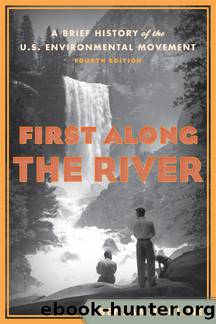First along the River by Kline Benjamin;

Author:Kline, Benjamin;
Language: eng
Format: epub
Publisher: Rowman & Littlefield Publishers, Incorporated
GEORGE BUSH AS THE ENVIRONMENTAL PRESIDENT
As Reagan's vice president for two terms, George Bush had supported deregulation and business development. But during the 1988 presidential campaign, he promised to usher in a new era of environmental concern and to be an "environmental president." After his election, Bush signaled his commitment by appointing William K. Reilly, a respected environmentalist, to head the EPA. But President Bush often fell short of his environmental promises as he struggled to balance economic and environmental concerns in his policies. As the economy slid into recession-unemployment surpassed 7 percent that year-public support for strong environmental legislation characteristically weakened. Still, environmental disasters continued to demand the public's attention.
Two major environmental problems arose in the 1980s that theoretically threatened the safety of the world-depletion of the ozone layer and global warming. Such a widespread danger, precipitated by the activities of industrialized nations, helped to publicize environmental issues and to promote a public call for government regulation of pollutants.
In the 1980s scientists had postulated that chlorofluorocarbon (CFC) gases rising into the stratosphere were depleting the earth's protective ozone layer. Although other experts questioned this theory, all doubt evaporated in 1986 when scientists discovered a hole in the ozone over the Antarctic. Studies linked the hole to excessive amounts of chlorine in the atmosphere, much of it carried there by CFC molecules.
Then, in 1988 scientists from the National Aeronautics and Space Administration (NASA) warned that rising carbon dioxide levels from petroleum use were causing a potentially catastrophic global-warming trend by trapping the sun's radiation close to earth, a phenomenon they dubbed the "greenhouse effect." The EPA went even further, concluding that rising sea levels could inundate 30 to 80 percent of U.S. coastal wetlands by the year 2100 if emissions of carbon dioxide and other "greenhouse" gases continued at the current rate.9 Adherents of the global warming theory argue that higher earth temperatures will cause extreme climatic changes and flooding and will disrupt agriculture around the world. Reports of global warming have been based on computer models, which skeptics contend are flawed and overstated.10
Faced with these official findings, the industrial nations were forced to take action. In 1987 the United States and twenty-three other countries signed the Montreal Protocol, pledging that they would phase out production and use of CFCs by 1999.
Arguably, the nation's greatest ecological disaster of the 1980s occurred in March 1989 when a 987-foot oil tanker, theExxon Valdez, ran aground off the coast of Alaska's Prince William Sound. Some 11 million gallons of crude oil spilled into the water, fouling 600 acres of coastal and marine habitats, killing thousands of sea otters and shore birds, and jeopardizing vital salmon and herring industries. The nation was outraged by the disaster. President Bush publicly described the spill as a "major tragedy," but he continued to support offshore oil exploration and drilling.11
Just as theExxon Valdez crisis was disappearing from the headlines, the EPA reported that air pollution had exceeded federal standards in more than a hundred cities during the summer of 1989.
Download
This site does not store any files on its server. We only index and link to content provided by other sites. Please contact the content providers to delete copyright contents if any and email us, we'll remove relevant links or contents immediately.
The Lonely City by Olivia Laing(4565)
Animal Frequency by Melissa Alvarez(4148)
All Creatures Great and Small by James Herriot(3980)
Walking by Henry David Thoreau(3681)
Exit West by Mohsin Hamid(3632)
Origin Story: A Big History of Everything by David Christian(3470)
COSMOS by Carl Sagan(3346)
How to Read Water: Clues and Patterns from Puddles to the Sea (Natural Navigation) by Tristan Gooley(3236)
The Inner Life of Animals by Peter Wohlleben(3099)
How to Do Nothing by Jenny Odell(3099)
Hedgerow by John Wright(3095)
How to Read Nature by Tristan Gooley(3073)
Project Animal Farm: An Accidental Journey into the Secret World of Farming and the Truth About Our Food by Sonia Faruqi(3013)
Origin Story by David Christian(2990)
Water by Ian Miller(2950)
A Forest Journey by John Perlin(2909)
The Plant Messiah by Carlos Magdalena(2745)
A Wilder Time by William E. Glassley(2686)
Forests: A Very Short Introduction by Jaboury Ghazoul(2668)
